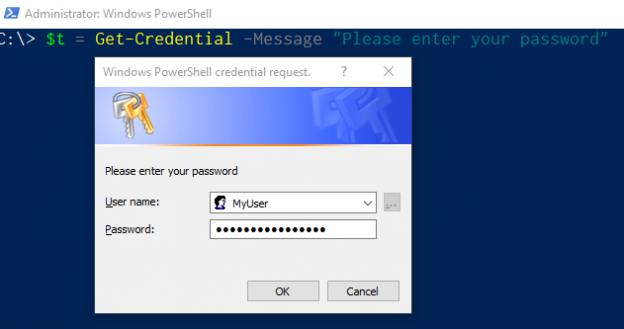
- GET PLAIN TEXT FROM PSCREDENTIAL HOW TO
- GET PLAIN TEXT FROM PSCREDENTIAL CODE
- GET PLAIN TEXT FROM PSCREDENTIAL PASSWORD
- GET PLAIN TEXT FROM PSCREDENTIAL PLUS
GET PLAIN TEXT FROM PSCREDENTIAL PASSWORD
PowerShell makes it inadvertently clear that you are passing a plain-text password here for sure. Pass a plain-text password to this cmdlet, and because it is plain text, we have to use the PlainText and Force parameters as well. How can I verify the user name and password that was supplied to the credential object Assuming you have permissions to the object, you can use the GetNetworkCredential method, for example: a Get-Credential a. Here we are simply writing the username and password directly into the PowerShell script as plaintext and then creating a PowerShell credential object that. The -Persist flag turns it into a traditionally mapped drive and the name specifies the letter assigned. New-PSDrive -Persist -Name P -Credential (Get-Credential) -PSProvider FileSystem -Root servershare. You do that by using the ConvertTo-SecureString cmdlet. You could just keep it native Powershell and not bother with decrypting: Powershell. To encrypt a password, you will convert a string to a secure string. This a pretty old one but a script block at times I revert back to in particular when there is a requirement to specify user credentials in order to complete a task. The PSCredential object needs a plain-text username and an encrypted string for the password.

To build a PSCredential object with no interaction first requires encrypting the password. SecurePassword Get-Content C:UserstmarshDocumentssecurePassword.txt ConvertTo-SecureString UnsecurePassword (New-Object PSCredential user.
GET PLAIN TEXT FROM PSCREDENTIAL CODE
KeyUsage KeyEncipherment,DataEncipherment,KeyAgreement -Type DocumentEncryptionCert. Application pass the Authorization code to Azure AD Token Endpoint to get various token like id, access and refresh tokens For fetching the user details.
GET PLAIN TEXT FROM PSCREDENTIAL PLUS
Plus writing scripts with a -Credential parameter is a nuisance because if you call Get-Credential in the script, it will always.

If you routinely have to log into a separate domain, it can be a nuisance to always have to run Get-Credential. Key Vault secrets, but we will limit to basic cases only as they give enough coverage and understanding to handle also other situations. From plain-text String From host input There are other ways or sources of SecureString, e.g. New-SelfSignedCertificate -DnsName pewa2303 -CertStoreLocation 'Cert:\CurrentUser\My'. October 4th, 2016 by Charlie Russel and tagged Get-Credential, PowerShell, PSCredential, SecureString. There are many ways for creating SecureString.Most often we need to create SecureString. It’s now time to create a PSCredential object from scratch! In order to store your credentials in an encrypted form you need to create a certificate for data encipherment. What if you’re working on an automated script that runs in a scheduled task or part of some more significant automation framework? In this case, there’s no one manning the console to type in a username and password. Every time it’s run, it will either prompt for the username and password at the console or pop up a dialog box asking for the username and password. Define clear text string for username and password string userName MyUserName string userPassword MySuperSecurePassword Convert to SecureString securestring secStringPassword ConvertTo-SecureString userPassword -AsPlainText -Force.

There’s no way to seamless pass values to it. To create the SecureString object the following syntax is used. This API is used under the hood of the Get -Credential command. Get monthly updates about new articles, cheatsheets, and tricks. A simple way to avoid having plaintext passwords in your script is to encrypt them in a. #Ends $SecurePass = ConvertTo - SecureString $O365ServiceAccountPwd - AsPlainText - Force $PSCredentials = New - Object Get-Credential cmdlet works fine and all but it’s interactive. GetNetworkCredential() ) only exists on PSCredential objects.$UserEmailWhoDeletedFiles = # Change the User Name who deleted Files.$O365ServiceAccount = # Your Service Account Name.

GET PLAIN TEXT FROM PSCREDENTIAL HOW TO


 0 kommentar(er)
0 kommentar(er)
